Graham Wilson runs Wilson Plant, an agri-plant hire business based in Muckamore, not far from Belfast International Airport. Work is split between industrial and agricultural operations, ranging from demolition duties to land drainage and land reclamation.
Some years ago, Graham decided to add to his business by offering a mobile crushing service. There were not many mobile crushers available, with most of them being large-scaled self-propelled machines which were unsuitable and over budget. However, Graham came across a Hammer mill crusher which he ended up buying. It wasn’t ideal, but it did the job.

Depending on the material, output per hour is in the region of 35t-40t.
In 2016, on a visit to Tyrone-based Herbst Engineering, Graham happened to lay eyes on the firm’s mobile PTO-powered Agri Crusher. He said: “It was pretty much what I was after from the start. I didn’t need nor want a self-propelled machine. Having its own engine and track unit would only bring about potential problems and haulage being the major issue. The Agri Crusher was the perfect fit for me, not needing a real high-output machine, but wanting a simple, easy worked and affordable solution that’s easily transported from farm to farm and manoeuvrable in tight areas.”
Graham bought the Herbst Agri Crusher there and then, and it has worked away trouble-free for the past four years. Not only was the concept a selling point but so too was the quality and workmanship that went into its manufacture.
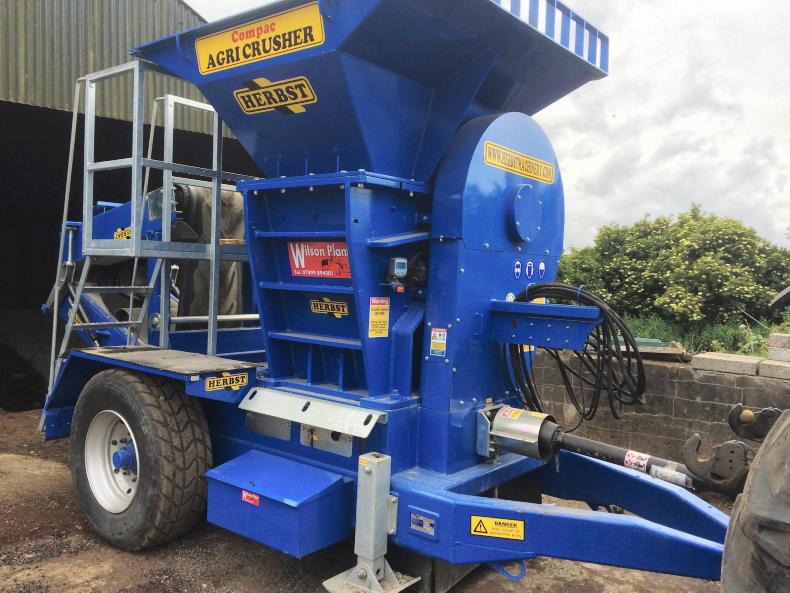
The crusher's minimum power requirement is 100hp.
Agri Crusher
Herbst makes agricultural and plant machinery, low loaders, dump trailers, livestock trailers, stone carts and slurry tankers, just to mention a few machines. In 2005, the company decided to diversify into the quarry and recycling industries, manufacturing mobile crushers and screening equipment.
Having had enquiries from customers similar to Graham, wanting a PTO-powered crusher that could be transported behind a tractor without the use of a low loader, the development of the Agri Crusher began.
Design and build
The Agri Crusher is built on a heavy duty chassis and 50km/h running gear. Its jaw box or crushing chamber is directly driven by the tractor’s PTO. This keeps the design simple, without the need for a gearbox, and keeps the cost down. Protection is provided via shear bolt on the PTO shaft.
The jaw box itself is 700m x 400m and has the capacity to handle material up to 35cm (14in) and crush it down to sizes ranging from 40-100mm (1.5-4in). Crush size is set by adjusting the jaws using the mounted hydraulic hand pump.
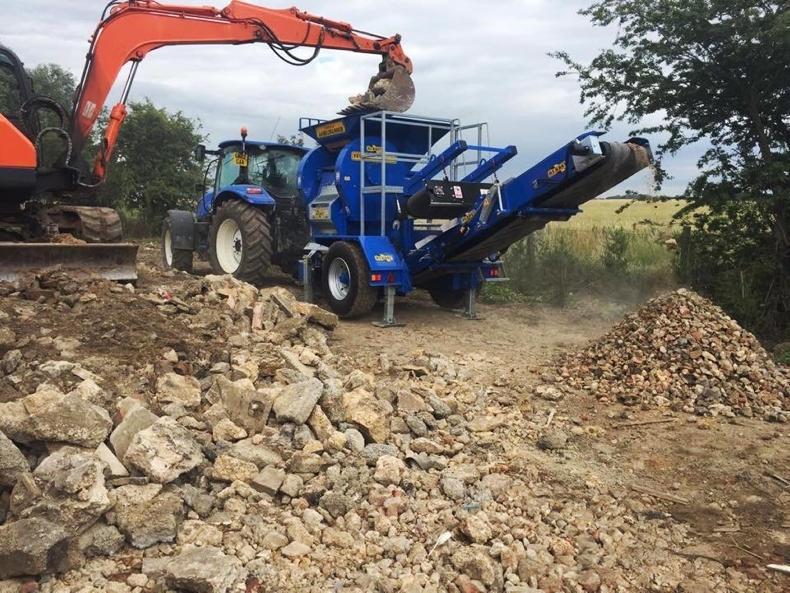
Depending on the material, output per hour is in the region of 35t-40t.
A 6ft hopper sits on top of the jaw box which is fed with a digger or loading shovel. Graham feeds his crusher with anything from an 8t to 13t digger and 2ft bucket depending on the job and machine available at the time. He likes to load with a larger digger mainly for the better visibility and extra reach as the hopper is just over 9ft high. A smaller machine is capable once working off a raised bank, he noted.
Three of the tractor’s spools are required to set up and operate the crusher, one for its four jack legs, which are raised for greater stability. Once positioned on site, another spool is used for unfolding the conveyor. The third spool is for powering the conveyor belt, which requires constant flow when crushing. Similar to controlling floor speed on a rear discharge dung spreader, a flow control valve mounted on the machine can be easily adjusted.
Graham said the crusher is quick to set up: “Once on site, you’d have the crusher unfolded from transport position to placing the first bucket of rubble into the hopper in five minutes.”
Power requirement and output
He said the crusher is easy to drive, currently powered with a Claas Arion 650 and previously a New Holland TM175. “We run the crusher in 1,000 economy with roughly 1,200rpm on the tractor, so the tractor’s under no load really.”
Herbst said a minimum of 100hp will be capable of powering the crusher which Graham said would be possible.
A high level of torque is required to crush material, so the incoming PTO speed of 540 rpm has to be reduced to 260 rpm and the level of torque increased. This reduction is done using a series of pulleys and belts. The Agri Crusher is fitted with a speed sensor and display which monitors shaft speed and alerts the operator if the machine is running too fast.
Graham said output varies depending on what is being fed into the crusher. “If you are feeding in concrete kerbs or blocks that are a good size for the jaws you’ll achieve up to 40t/hr. On a good day’s crushing you would crush in the region of 350t.”
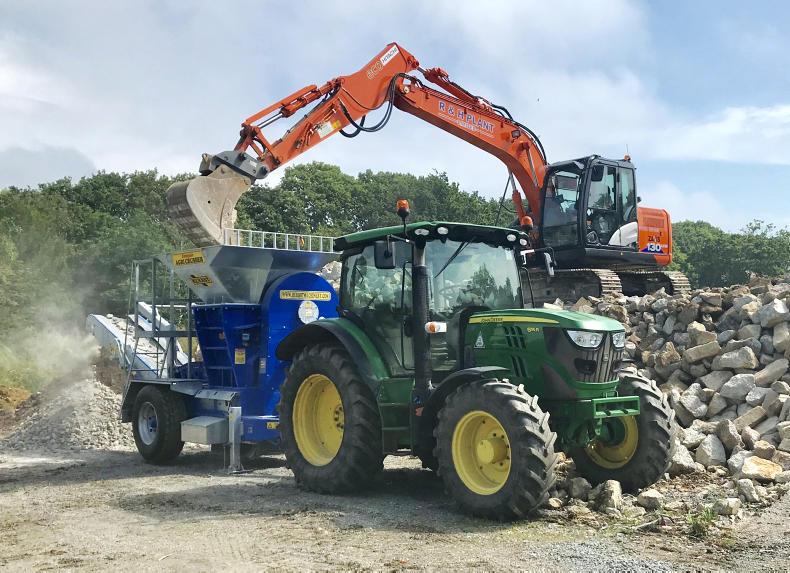
Depending on the material, output per hour is in the region of 35t-40t.
Graham noted how it’s important to keep a close eye on what’s going into the hopper so that no reinforced concrete is being loaded. Although the crushing chamber is fitted with a toggle plate which gives way in the event of a foreign object entering, there is still a possibility that steel, for example, could make it through and damage the conveyor belt. Herbst offers a magnet option which catches metal just as it makes its way on to the conveyor belt. However, Graham wanted to keep costs low when buying the machine and didn’t opt for the magnet. Most of the material Graham handles is crushed to 4in.
Pricing and running costs
Most of Graham’s work with the crusher is industrial, with roughly 30% agricultural, crushing mainly rubble for local farmers. Graham says the crusher’s workload has increased purely by word of mouth. If the customer is loading the crusher, an hourly rate of £55 (€62) is charged, which breaks down to just shy of £1.40 (€1.55) per tonne if an output of 40t/hr can be achieved.
If a digger is to be supplied for loading, an additional £25 (€28.50) is charged per hour. So, from a customer’s point of view, it’s a cost-effective way of making use of rubble for farm roadways or foundations.
Graham said that after four years of use, running costs have been minimal. “It is fitted with heavy-duty bearings which are greased regularly and the fact they aren’t running at high speeds has seen them last. I suspect at some point jaws will have to be replaced but for now there’s more work in them.”
The spec
Model: Argi-Crusher
Jaw size: 700mm x 400mm
Crush size: 40mm-150mm
Power requirement: 100hp
Output: 30-40t/h
Weight: 7,800kg
Feed height: 9ft 2in
Discharge height: 6ft 2in
Hopper length: 5ft 8in
Hopper width: 6ft 2in
Price: £41,000 plus VAT
(€51,500 plus VAT)
Graham Wilson runs Wilson Plant, an agri-plant hire business based in Muckamore, not far from Belfast International Airport. Work is split between industrial and agricultural operations, ranging from demolition duties to land drainage and land reclamation.
Some years ago, Graham decided to add to his business by offering a mobile crushing service. There were not many mobile crushers available, with most of them being large-scaled self-propelled machines which were unsuitable and over budget. However, Graham came across a Hammer mill crusher which he ended up buying. It wasn’t ideal, but it did the job.

Depending on the material, output per hour is in the region of 35t-40t.
In 2016, on a visit to Tyrone-based Herbst Engineering, Graham happened to lay eyes on the firm’s mobile PTO-powered Agri Crusher. He said: “It was pretty much what I was after from the start. I didn’t need nor want a self-propelled machine. Having its own engine and track unit would only bring about potential problems and haulage being the major issue. The Agri Crusher was the perfect fit for me, not needing a real high-output machine, but wanting a simple, easy worked and affordable solution that’s easily transported from farm to farm and manoeuvrable in tight areas.”
Graham bought the Herbst Agri Crusher there and then, and it has worked away trouble-free for the past four years. Not only was the concept a selling point but so too was the quality and workmanship that went into its manufacture.

The crusher's minimum power requirement is 100hp.
Agri Crusher
Herbst makes agricultural and plant machinery, low loaders, dump trailers, livestock trailers, stone carts and slurry tankers, just to mention a few machines. In 2005, the company decided to diversify into the quarry and recycling industries, manufacturing mobile crushers and screening equipment.
Having had enquiries from customers similar to Graham, wanting a PTO-powered crusher that could be transported behind a tractor without the use of a low loader, the development of the Agri Crusher began.
Design and build
The Agri Crusher is built on a heavy duty chassis and 50km/h running gear. Its jaw box or crushing chamber is directly driven by the tractor’s PTO. This keeps the design simple, without the need for a gearbox, and keeps the cost down. Protection is provided via shear bolt on the PTO shaft.
The jaw box itself is 700m x 400m and has the capacity to handle material up to 35cm (14in) and crush it down to sizes ranging from 40-100mm (1.5-4in). Crush size is set by adjusting the jaws using the mounted hydraulic hand pump.

Depending on the material, output per hour is in the region of 35t-40t.
A 6ft hopper sits on top of the jaw box which is fed with a digger or loading shovel. Graham feeds his crusher with anything from an 8t to 13t digger and 2ft bucket depending on the job and machine available at the time. He likes to load with a larger digger mainly for the better visibility and extra reach as the hopper is just over 9ft high. A smaller machine is capable once working off a raised bank, he noted.
Three of the tractor’s spools are required to set up and operate the crusher, one for its four jack legs, which are raised for greater stability. Once positioned on site, another spool is used for unfolding the conveyor. The third spool is for powering the conveyor belt, which requires constant flow when crushing. Similar to controlling floor speed on a rear discharge dung spreader, a flow control valve mounted on the machine can be easily adjusted.
Graham said the crusher is quick to set up: “Once on site, you’d have the crusher unfolded from transport position to placing the first bucket of rubble into the hopper in five minutes.”
Power requirement and output
He said the crusher is easy to drive, currently powered with a Claas Arion 650 and previously a New Holland TM175. “We run the crusher in 1,000 economy with roughly 1,200rpm on the tractor, so the tractor’s under no load really.”
Herbst said a minimum of 100hp will be capable of powering the crusher which Graham said would be possible.
A high level of torque is required to crush material, so the incoming PTO speed of 540 rpm has to be reduced to 260 rpm and the level of torque increased. This reduction is done using a series of pulleys and belts. The Agri Crusher is fitted with a speed sensor and display which monitors shaft speed and alerts the operator if the machine is running too fast.
Graham said output varies depending on what is being fed into the crusher. “If you are feeding in concrete kerbs or blocks that are a good size for the jaws you’ll achieve up to 40t/hr. On a good day’s crushing you would crush in the region of 350t.”

Depending on the material, output per hour is in the region of 35t-40t.
Graham noted how it’s important to keep a close eye on what’s going into the hopper so that no reinforced concrete is being loaded. Although the crushing chamber is fitted with a toggle plate which gives way in the event of a foreign object entering, there is still a possibility that steel, for example, could make it through and damage the conveyor belt. Herbst offers a magnet option which catches metal just as it makes its way on to the conveyor belt. However, Graham wanted to keep costs low when buying the machine and didn’t opt for the magnet. Most of the material Graham handles is crushed to 4in.
Pricing and running costs
Most of Graham’s work with the crusher is industrial, with roughly 30% agricultural, crushing mainly rubble for local farmers. Graham says the crusher’s workload has increased purely by word of mouth. If the customer is loading the crusher, an hourly rate of £55 (€62) is charged, which breaks down to just shy of £1.40 (€1.55) per tonne if an output of 40t/hr can be achieved.
If a digger is to be supplied for loading, an additional £25 (€28.50) is charged per hour. So, from a customer’s point of view, it’s a cost-effective way of making use of rubble for farm roadways or foundations.
Graham said that after four years of use, running costs have been minimal. “It is fitted with heavy-duty bearings which are greased regularly and the fact they aren’t running at high speeds has seen them last. I suspect at some point jaws will have to be replaced but for now there’s more work in them.”
The spec
Model: Argi-Crusher
Jaw size: 700mm x 400mm
Crush size: 40mm-150mm
Power requirement: 100hp
Output: 30-40t/h
Weight: 7,800kg
Feed height: 9ft 2in
Discharge height: 6ft 2in
Hopper length: 5ft 8in
Hopper width: 6ft 2in
Price: £41,000 plus VAT
(€51,500 plus VAT)







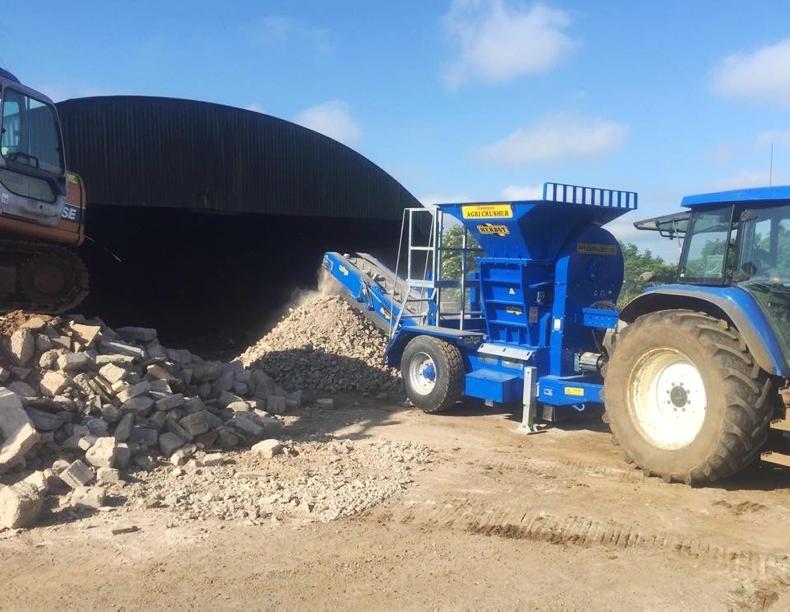


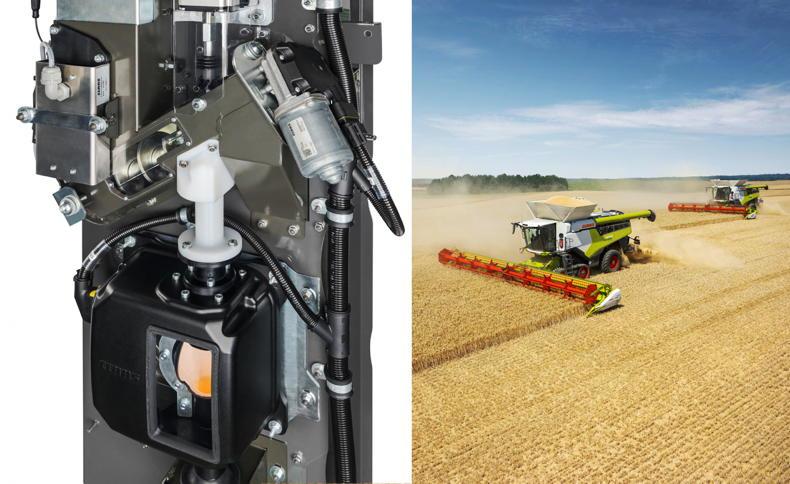

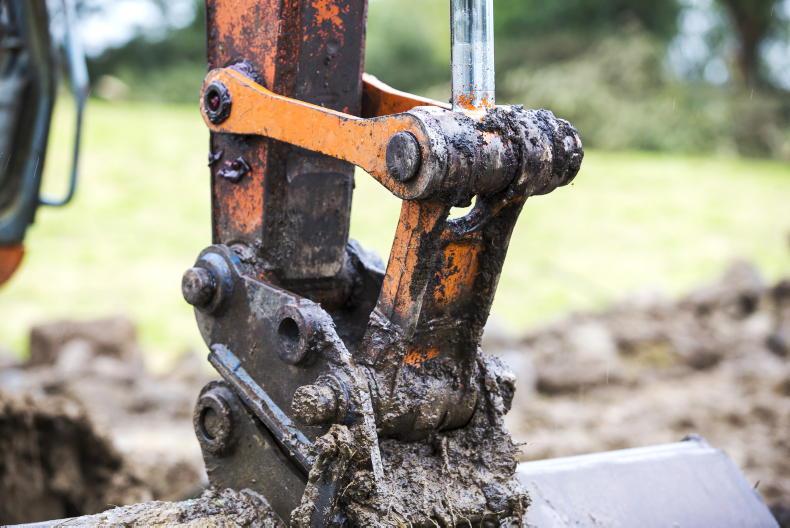
SHARING OPTIONS